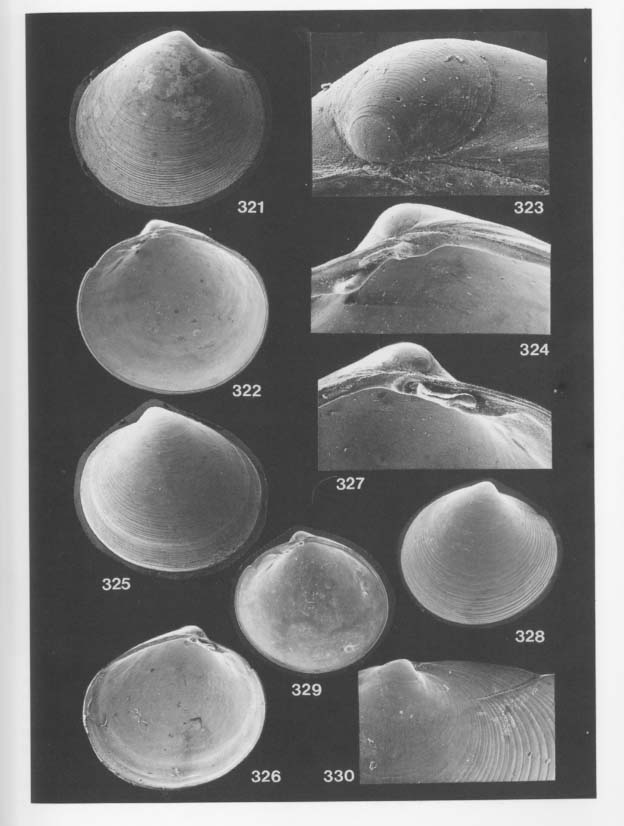Systematic Description
Kelliella japonica sp. nov.
|
  |
1992. Kelliella sp., Kase and Hayami, Jour. Moll. Studies, vol.58, p.448, listed.
Type and material.—Holotype: RM19543a, a right valve, from the bottom sediments of "Shodokutsu" of Ie Islet, Okinawa. Paratype: RM19542 (dead) from "Fool's Palace", RM19610 (dead) from "Coral Hole" of Shimoji Islet and RM19543 (dead) from the type locality. No living specimens have been found.
Diagnosis.— Small-sized species of Kelliella characterized by suborbicular outline, densely spaced commarginal lamellae, a sharp groove clearly delimiting wide lunule and giving a distinct notch to antero-dorsal margin, a fine furrow along the circumference of RV and a corresponding ridge in LV, and cyprinoid hinge consisting of two subparallel teeth in RV and a tubercular and a winding lamellar tooth in LV.
Description.—Shell generally smaller than 2.5 mm in length, suborbicular but slightly longer than high, strongly inflated, white and shiny, Umbo prosogyrous, located about two-fifths of shell length from anterior end. Antero-dorsal and posterodorsal margins gently arcuate without umbonal angulation. A narrow sharp groove delimits wide lunule, giving a distinct small notch to the antero-dorsal margin. Surface marked with fine irregular commarginal lamellae, the interval of which becomes denser toward ventral margin. Internal surface shiny, without marginal crenulations. A fine internal furrow and a corresponding ridge run along the whole circumference (except for the hinge plate) in RV and LV, respectively. Ligament opisthodetic, external. Hinge teeth of cyprinoid-type, as formulated: 3a (1) 3b/2a-2b 4b; 3a lamellar and nearly horizontal, 1 distant from umbo (might better be called AI), 2a-2b forming a winding subhorizontal tooth, 3b and 4b tubercular; lateral teeth undeveloped. Pd I relatively small, D-shaped, ranging 75-120 µm in maximum diameter; Pd II distinct; veliconch (Pd I +Pd II) ranging 158-199 µm in diameter, commarginally striated.
Remarks.— The present species is represented only by several disarticulated valves. Every essential feature of the shell indicates that it is a congener with deep-water species of Kelliella. In fact, the size, disposition of hinge teeth, well-defined lunule, features of Pd I and Pd II and other essential shell characters are surprisingly similar to those of the type species of Kelliella, K. miliaris (Philippi, 1844) [=K. abyssicola Sars, 1870] from the lower sublittoral and bathyal depths of the northern Atlantic and Mediterranean, an Iceland specimen of which was well illustrated by Warén (1989). The umbo of the present species, howver, looks somewhat lower and broader than that of K. miliaris.
In the shell shape and hinge structure it also resembles Kelliella galatheae Knudsen, 1970, from the abyssal bottom of the eastern Pacific and Kelliella simdaensis Knudsen, 1970, from the hadal bottom of Sunda Trench. It differs, however, from K. galatheae in the smaller umbo and much smaller shell size and from K. sundaensis in the more clearly delimited lunule. Kelliella barbara Studencka, 1987, from the Middle Miocene of Poland also reveal similar hinge structure, but the umbo is more highly raised above the dorsal margin in that species. Kelliella elegantula Bernard, 1989, from British Columbia differs from the present species in the more elongated and lamellar posterior cardinal teeth.
In Japanese waters no extant species of Kelliella had been recorded, but the Holocene lower sublittoral-bathyal fossil bed at an islet Moeshima in Kinko Bay near Kagoshima of Kyushu yields numerous specimens of an undoubted species, Kelliella nakayamai Habe, 1953. As our SEM observations show, however, the fossil species is characterized by the broader umbo, better differentiated cardinal tooth 2a-2b, shallower groove demarcating the lunule and a more transversely elongated shell than the present species.
Distribution.— Rare in a few sublittoral caves of Ie and Shimoji Islet, Ryukyu Islands.